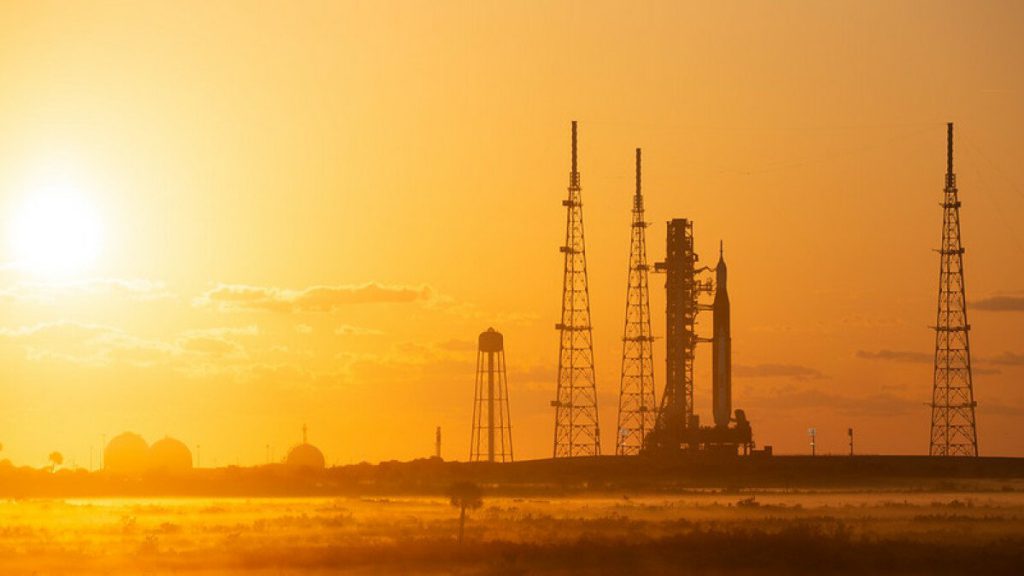NASA’s dress rehearsal for its Artemis mega moon rocket hasn’t been the seamless test the space agency hoped for.
The fully assembled rocket, capped with the Orion spacecraft, was in the midst of a demonstration at its Florida launchpad last week when it encountered a series of mishaps. The crucial test, filling the rocket tanks with liquid fuel, has revealed bad valves, malfunctioning fans, and leaks in the 32-story rocket.
Rather than continuing, the team has decided to wheel the rocket back into storage for repairs. It’s unclear how damaging this setback will be for the first lunar mission timeline or the overall Artemis space exploration campaign.
“We have had a number of challenges to overcome, and those challenges require perseverance, and that perseverance, in turn, is building character within the team,” said Mike Sarafin, Artemis mission manager, during a call with reporters on Monday. “We are not ready to put a pin on the calendar yet.”
NASA originally expected the so-called “wet” dress rehearsal to take just two days. The team called off the drill Thursday after a third failure to completely fuel the Space Launch System, or SLS. The latest problem discovered is a liquid hydrogen leak, according to the agency.
Now NASA plans to cart the 5.75 million-pound rocket, thought to be the most expensive ever built, back to its towering warehouse. The slow crawl from the pad is expected to begin April 26.
There technicians will replace a helium valve on the upper stage of the rocket and fix a small leak on the tail service mast umbilical, which provides liquid oxygen and hydrogen lines and power to the rocket’s core stage. An offsite supplier of gaseous nitrogen, needed for the test, also will make upgrades to the system.
NASA officials say they’ll use the downtime to mull options for attempting the dress rehearsal again. Originally, the agency didn’t intend to set a date for the maiden moon voyage, a test in its own right, until after completing the fueling and countdown simulation at the launchpad. A new option under consideration may mean orchestrating a back-to-back dress rehearsal and launch in one rollout, said Charlie Blackwell-Thompson, Artemis launch director.

Credit: NASA/Joel Kowsky
At one point, liftoff was discussed for May. On Monday, team leaders described a June launch as challenging. They were even hesitant to give an estimate on how long the repairs could take, one vaguely saying “weeks.”
It’s been a long time since NASA had a rocket of this magnitude, capable of sending heavy loads of cargo and astronauts into deep space. Not only is SLS built to travel to the moon, it’s expected to one day send the first crewed flight to Mars. Robotic scientific journeys to Saturn and Jupiter also could be in its future.
Wayne Hale, the former Space Shuttle program manager and flight director, criticized NASA for the way it has handled the test. Experts in the field would anticipate hiccups, he said, adding he guessed it would take about five attempts before getting the fuel-loading process right.
But that’s not how the demonstration has been conveyed to the public.
“The reason this looks so bad is a failure to explain the situation clearly and provide realistic expectations to the public,” he said in a tweet on Saturday.
Further, he added in another tweet: “I hope they will learn that it is better to be transparent and realistic with the taxpayers who are, after all, paying for it.”
NASA is readying the rocket for a mission to the moon, known as Artemis I, the first in a series of planned voyages. Though the upcoming launch won’t include astronauts, the monthlong flight will allow the United States to send a crew on the next, more complex mission, Artemis II.
Federal government officials have estimated each Artemis launch could cost over $4 billion.

